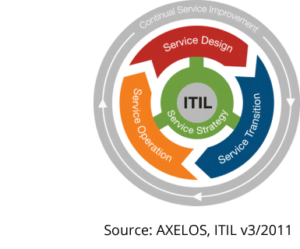Understanding ITIL
ITIL is a globally recognized framework that provides best practices for IT service management (ITSM). It offers a set of guidelines and processes to align IT services with the needs of the business, ensuring efficient operations and improved customer satisfaction. ITIL focuses on delivering value-driven services, enabling organizations to deliver high-quality solutions while maintaining cost-effectiveness.
Key Components of ITIL
ITIL comprises several key components that form a cohesive approach to IT service management. Let’s explore some of the core elements:
- Service Strategy:
Service Strategy defines how an organization plans to deliver value and meet business objectives. It involves understanding customer needs, defining service portfolios, and establishing strategic goals. - Service Design:
Service Design focuses on designing IT services that align with business requirements. It encompasses processes such as service catalog management, service level management, and capacity management, ensuring that services are well-designed, documented, and efficient. - Service Transition:
Service Transition involves the planning and coordination of changes to IT services. It includes activities such as change management, release management, and knowledge management, ensuring that new or modified services are seamlessly integrated into the operational environment. - Service Operation:
Service Operation is responsible for managing IT services on a day-to-day basis. It involves incident management, problem management, and event management, ensuring that services are delivered efficiently and disruptions are minimized. - Continual Service Improvement (CSI):
CSI is an iterative process that focuses on continually enhancing IT services. It involves analyzing performance metrics, identifying areas for improvement, and implementing changes to optimize service delivery.
Implementing ITIL in Practice
To effectively utilize ITIL, organizations can follow these steps:
- Assess Current Processes:
Evaluate existing ITSM processes and identify areas for improvement. Determine which ITIL processes are most relevant to your organization’s needs. - Define Objectives and Scope:
Clearly define the objectives and scope of the ITIL implementation project. Establish measurable goals that align with the organization’s strategic priorities. - Develop a Roadmap:
Create a roadmap outlining the sequence of ITIL processes to be implemented, considering dependencies and resource requirements. Prioritize processes based on their impact and potential benefits. - Training and Awareness:
Provide IT staff and stakeholders with appropriate ITIL training and awareness sessions. This will ensure a common understanding of ITIL concepts and foster buy-in from all involved parties. - Process Implementation:
Gradually introduce ITIL processes, starting with those that will have the most immediate impact. Ensure that processes are well-documented, clearly communicated, and supported by appropriate tools and technologies. - Monitor and Measure:
Establish metrics and key performance indicators (KPIs) to monitor the effectiveness of ITIL processes. Regularly review performance data and use it to drive continual service improvement initiatives. - Adapt and Evolve:
ITIL implementation is an ongoing journey. Continuously adapt and refine processes based on feedback, changing business needs, and emerging industry trends. Embrace a culture of continuous improvement to drive long-term success.
Benefits of ITIL Implementation
Implementing ITIL brings several benefits to organizations, including:
- Improved Service Quality:
ITIL focuses on delivering high-quality services that meet or exceed customer expectations. This leads to improved customer satisfaction, loyalty, and retention. - Enhanced Efficiency:
By streamlining processes and reducing redundancies, ITIL helps organizations optimize resource utilization, minimize downtime, and improve operational efficiency. - Effective Change Management:
ITIL’s change management processes enable organizations to handle changes smoothly, reducing the risk of disruptions and ensuring seamless service transitions. - Alignment with Business Objectives:
ITIL promotes a holistic approach to ITSM, aligning IT services with the strategic goals and priorities of the business. This alignment enhances the value delivered by IT to the organization.
Conclusion:
ITIL provides a robust framework for IT service management, enabling organizations to deliver high-quality services while aligning IT with business objectives. By implementing ITIL processes, businesses can streamline operations, enhance service delivery, and drive continual service improvement. Embrace ITIL as a guiding principle to optimize your IT services and stay ahead in today’s competitive landscape
